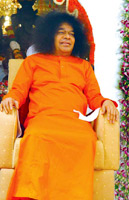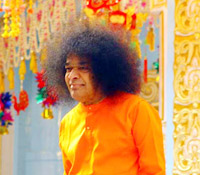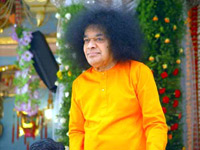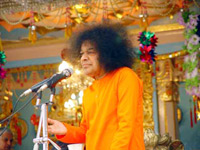PRASANTHI
NEWS
26th March 2005
 On
26th March, devotees from Bihar and Jharkhand had assembled
at Prasanthi Nilayam to celebrate Holi in the Divine Presence.
It was the first time that holy celebrations were held at
Prasanthi Nilayam. Sai Kulwant Hall was decked with silver
and gold shining decorative strips. Banners with the message
of Holi adorned the pillars of the Hall. Holi – the
festival of Love and Joy…and so on. Devotees from Bihar
and Jharkhand were seated awaiting Bhagawan’s Darshan.
Several balloons were tied in the shape of a big inverted
‘V’ acting as a border for a deep blue screen
with cutouts of a flute and several hands representing Lord
Krishna and the Gopalas. This served as the backdrop for the
actors who were to enact a drama in the evening. On
26th March, devotees from Bihar and Jharkhand had assembled
at Prasanthi Nilayam to celebrate Holi in the Divine Presence.
It was the first time that holy celebrations were held at
Prasanthi Nilayam. Sai Kulwant Hall was decked with silver
and gold shining decorative strips. Banners with the message
of Holi adorned the pillars of the Hall. Holi – the
festival of Love and Joy…and so on. Devotees from Bihar
and Jharkhand were seated awaiting Bhagawan’s Darshan.
Several balloons were tied in the shape of a big inverted
‘V’ acting as a border for a deep blue screen
with cutouts of a flute and several hands representing Lord
Krishna and the Gopalas. This served as the backdrop for the
actors who were to enact a drama in the evening.
Swami came out at 3.15 p.m., cut across the centre of the
Hall and proceeded straight to the interview room. At 3.35
p.m. He came out and sat down on the sofa amidst chants of
the Vedic hymn Anandavalli. Marigold garlands adorned the
brass railings in front of Swami’s chair. At 3.50 p.m.
the Veda chanting stopped. The youth of Bihar entered the
performing area. In the first scene, they explained the significance
of Holi through the episode of Holika. Then came the actual
celebration with all colours! The youth dressed in spotless
whites threw colours on each other and into the air with gusto
and joy! Swami was watching all the celebration with a smile
on His face!
The rest of the play went on to convey that
Holi signifies burning of the Asuric tendencies in man. It
stands for destruction of prejudice, selfish motives and the
Rajasic and Thamasic traits in man. It advocates the strengthening
of Love for God through resolving all differences. The play
ended at 4.15 p.m. with the song ‘Sai Namamu Dorake
Kada…’ This was followed by group photographs
with Swami and Bhajans. At 5.15 p.m. Swami was offered Arati
and then He retired for the day.
1st
April 2005
Students had their last exam on the 31st
of March and today was the first day of their summer vacation.
In the evening Swami came out at 3.00 p.m. and sat outside
for nearly one hour. Most of the students were leaving for
their home towns for vacation. Therefore, they had a wonderful
Darshan. It was like a parting gift for the boys! Subsequently,
Swami went into the interview room and came out later for
Bhajans.
Many of the evenings, Swami would come into
the Bhajan Hall and spend a few minutes talking to students.
On one of the occasions, He asked the boys who all had been
to Kodaikanal. On another occasion, He materialised a ring
for one student. Therefore, these sessions have become very
valuable and students wait eagerly for 4.00 p.m. when they
are allowed into the Bhajan Hall. The moment the signal is
given, they rush into the Hall!
7th
April 2005
Bhagawan came out for Darshan in the evening
at 3.05 p.m. He sat down on the sofa placed on the dais amidst
the chanting of Mahanarayanopanishad. It was 3.50 p.m. when
Swami called for Sri B.N. Narasimha Murthy, Warden of Brindavan
Campus of the Institute. Bhagawan asked him to share his thoughts
with the audience. Sri Narasimha Murthy spoke about the evolution
of the Vedic thought in India, which took place in 4 stages.
In the first stage, the Veda Mantras praise the various entities
of the Creation/Universe. In the second stage, they speak
about perceiving the Lord within oneself. In the third stage,
they exclaim Ekam Sath Viprahah Bahuda Vadanti, Antar Bahischa
Tat Sarvam … In the final and fourth stage, the thought
evolves to the highest level of Advaita. Ekam Sath Sarva Bhutantaratma.
It talks about perceiving Unity in Diversity.
The rest of his talk was centred on the
life and experiences of Dr. Alreja, an ardent devotee of Bhagawan
who came to Swami way back in 1965 and who till now serves
in the General Hospital at Puttaparthi. Mr. Narasimha Murthy
shared several interesting episodes related to Swami from
the life of Dr. Alreja, listening to which, everyone was struck
with wonder and awe! He concluded his talk at 4.20 p.m.
His talk was followed by another talk from
a student of the 1st M.Sc. class – Sai Giridhar. Sri
Giridhar shared his thoughts about the lessons he had learnt
at the Lotus Feet and especially about the learning experience
he had gone through putting up several programmes in Sai Kulwant
Hall in the Divine Presence. He delivered a very scholarly
talk that was appreciated by one and all. He concluded his
talk at 4.35 p.m. Swami was very pleased and spoke to him
for some time and their dialogue culminated in the materialisation
of a unique ring for him!
At 4.45 p.m. Bhajans began and at 5.00 p.m. Swami was offered
Arati.
9th
April 2005
 A
brief note on Ugadi Festival: Festivals are celebrated every
year in the remembrance of past events. All the major Hindu
festivals have their own purpose and significance, i.e., to
show their relevance and importance in the context of the
eternal world cycle of history. India's rich heritage with
its numerous festivals celebrated throughout the year, provides
succour and faith, as each occasion has its own distinct value,
beauty and ritual practice. Amongst the numerous festivals
of India, Ugadi is celebrated with festive fervour in Maharashtra,
Karnataka and Andhra Pradesh. While it is called Ugadi in
Andhra Pradesh and Karnataka, in Maharashtra it is known as
Gudipadava". A
brief note on Ugadi Festival: Festivals are celebrated every
year in the remembrance of past events. All the major Hindu
festivals have their own purpose and significance, i.e., to
show their relevance and importance in the context of the
eternal world cycle of history. India's rich heritage with
its numerous festivals celebrated throughout the year, provides
succour and faith, as each occasion has its own distinct value,
beauty and ritual practice. Amongst the numerous festivals
of India, Ugadi is celebrated with festive fervour in Maharashtra,
Karnataka and Andhra Pradesh. While it is called Ugadi in
Andhra Pradesh and Karnataka, in Maharashtra it is known as
Gudipadava".
Hindus have always given pride of place to festivals,
as it is a time for getting together as families. The occasion
can be based on a seasonal change, a social or religious theme.
The New year festival or Ugadi comes close on the heels of
Holi. Ugadi name has been changed from Yuga Aadi (Yuga + Aadi
means "Beginning of New age"). It is believed that
the creator of the Hindu pantheon Lord Brahma started creation
on this day - Chaitra suddha padhyami or the Ugadi day. Also
the great Indian Mathematician Bhaskaracharya's calculations
proclaimed the Ugadi day from the sunrise on as the beginning
of the new year, new month and new day. The onset of spring
also marks a beginning of new life with plants (barren until
now) acquiring new life, shoots and leaves. Spring is considered
the first season of the year hence also heralding a new year
and a new beginning. The vibrancy of life and verdant fields
and meadows full of colorful blossoms signifies growth, prosperity
and well-being.
Ugadi marks the beginning of a new Hindu
lunar calendar with a change in the moon's orbit. It is a
day when mantras are chanted and predictions made for the
New Year. Traditionally, the Panchanga Sravanam or listening
to the yearly calendar was done at the temples. On Ugadi day,
people wake up before the break of dawn and take a head bath
after which they decorate the entrance of their houses with
fresh mango leaves.
On this day, it is the practice to eat what
is called "Ugadi Pacchadi (Ugadi Chutney). This Chutney
is made from neem flowers, mango juice, honey, sugar and other
ingredients with different tastes. The inner significance
of this preparation is to indicate that life is a mixture
of good and bad, joy and sorrow and all of them have to be
treated alike. All experiences have to be treated with equanimity.
Everyone should make a resolve that he will face calmly whatever
happens in this year, accepting it with good grace. Welcome
everything. Consider everything as for one’s own good.
Men should rise above sorrow and happiness, success and failure. This is the primary
message of the Ugadi festival.
sorrow and happiness, success and failure. This is the primary
message of the Ugadi festival.
Ugadi at Prasanthi Nilayam: We wish you all
a very very Happy Ugadi. The entire Sai Kulwant Hall was decorated
with brightly coloured festoons. The huge red Chinese lamps,
floral decorations on the dome and around Ganesha gave a festive
look to the Hall. Nadaswaram was being played to welcome Bhagawan.
At 7.40 a.m., Swami came out in the golf cart. He took a full
round blessing everybody with His Darshan and by 7.50 a.m.
He sat on the sofa placed at the centre of the dais.
The Hyderabad youth were seated in front
next to the Veda chanting group. They were ready with a special
programme for the occasion. Swami called one Primary School
student and asked him to chant the Veda. The lucky boy stood
face to face with Bhagawan and kept chanting Veda for a long
time. Swami was looking straight into his eyes with so much
of Love and Grace. After a while, Swami spoke to him and blessed
him with a gold chain!
At 8.15 a.m. the former Vice Chancellor of the Institute, Sri
S.V. Giri was summoned by Bhagawan to address the audience.
Sri S.V. Giri began his talk with a recap of the events in
the last year and the various difficulties that the world
had faced. In this context, he drew attention to the ever
growing need for human values in life. He spoke about the
relationship between Vyashti and Samashti and how one should
make an attempt to see Parameshti (the Lord) through Samashti
(society). Subsequently, he elaborated on the eternal verities
expounded in the Sikshavalli saying that mere chanting is
not adequate and one should understand and internalise the
meaning of the Vedas.
At 8.35 a.m. the Hyderabad party began their
programme with Swami’s blessings. It started with a
Panchanga Pandit (Almanac Scholar) reading the almanac –
which is commonly called the ‘Panchanga Sravanam’.
The Pandit began with reading out the name of the coming year
– ‘Parthiva Nama Samvatsaram’ and prayed
that it should become Parthi Nama Samvatsaram. He reminded
the people of their good fortune to be witness to the Holy
80th year of the Avatar. He demonstrated with some calculations
how various aspects of this year total up to the number of
80, symbolic of the 80th year of the Avatar.
He then read out the positions of various
stars and constellations and briefly explained their significance.
He concluded by saying that though the science of Panchanga,
conventionally is understood as the science of stars and planets
and their implications for the world; it truly means the Pancha
Angas and using the same to be happy and make others happy.
His final punch line drew loud applause. He said that all
these Grahas (planets) and their influence can have no impact
on us in the powerful presence of Swami’s Anugraha (Grace)!!
The Panchanga Sravanam was followed by a
music programme by the Hyderabad youth. The programme was
packed with enthusiasm and vigour! They had selected very
good songs, some being new and the rest a collection of songs
sung on earlier occasions by them in the Divine Presence.
One member gave a brief commentary between the songs with
his soothing and mellifluous Telugu. It was 9.40 a.m. by the
time the programme concluded. The final song was Sai Matha
Biddale Mein Andaram. It was a grand finale for the programme!
This was followed by a photograph session
with Swami and Prasadam distribution. Swami was offered Arati
at 9.50 a.m. and then He retired to His abode.
At 3.15 p.m. Swami was out again to delight
everyone with His Divine Darshan. He took a full round and
then sat down on the sofa. Swami was enquiring about the speakers
for the evening. He called Sri Sanjay Sahni, Principal of
the Brindavan Campus of the Institute. Sri Sanjay Sahni began
his impromptu talk at 3.25 p.m. He stole the hearts of the
audience with his expressive delivery, poignant illustrations
and scholarly insights.
He began with the description of God as the
One who embodies Time, transcends Time, and from whose womb
Time is born! He stressed on the great significance of the
present time when we are fortunate to be the contemporaries
of the Avatar! Jantunam Nara Janma Durlabham (out of all living
beings, human birth is the rarest). He explained the importance
of human birth and how it should be spent in the service of
others.
He categorised people into 4 stages. The
first being the money-minded. These people work merely for
the sake of monetary benefits. They are ready to do just anything
for the sake of money! The second category of people are the
career-minded. These people have only the three P’s
in mind. Pay, Prospects and Promotion! The next category is
the Professionals. These people put in a lot of effort to
excel in their field of work and try to achieve perfection
in whatever they do. Still higher is the service-minded. This
category of people work for their self-satisfaction. Yet however,
there are traces of selfishness even in them. The highest
category is the visionary.
He then went on to describe the unsullied
and pure Love of Bhagawan, through various illustrations.
He recalled the episode at Kodaikanal where students and staff
were helping in clearing the ground for making a new Bhajan
Hall. Watching this, even the hawkers who earned their livelihood,
selling trinkets on the road along the lake, prayed to Swami
to give them an opportunity to participate in this service.
They offered to continue the work when the students and staff
would go for taking rest in the afternoon. That was their
Love for Swami!
He then went on to describe how during the
Narayana Seva in the Hill View Stadium, Bhagawan watching
the 8th class students sitting in the Mandir with no work
allotted to them, had personally guided them to help in serving
water to the people. He did not want anybody to be left out
from the service activities.
He also spoke about the inspiring message
given by Bhagawan in the Bhajan Hall to the staff before the
commencement of the first Grama Seva. Swami was so moved by
the episode of a mother poisoning herself and her children
due to extreme poverty. This amply demonstrated that God was
no alien entity sitting in the heavens above but was very
much part of humanity.
He concluded his talk with a Kabir’s
Doha (couplet) which says that when we come to the world,
we cry and the world laughs. But let us conduct ourselves
in such a way that when we go, the world cries and we laugh
– for we have finally reached our destination!
It was 4.05 p.m. and Bhagawan signalled for
the Discourse table to be arranged. (Full text of Ugadi Discourse
is given separately.) It was 5.25 p.m. and a group from Visakhapatnam
presented their music programme. This went on till ten past
six. Prasadam was distributed in the end. Pocket calendars
were distributed to all. The uniqueness was that it was a
Parthiva Samvatsara calendar starting from April 2005 to March
2006! The past year has come to a close. The New Year –
Parthiva Year has begun!
Bhagawan was offered Arati and then He retired
for the day.
10th
April 2005
Bhagawan came out for Darshan at 8.40 a.m. As He took a full
round of the Hall, He collected letters from many devotees and
from almost all the students. As He approached the Veda group,
Swami asked for the golf cart to be taken a little back. He
spotted a boy in the third line. Swami called him and took his
letter. The joy on the face of the student was indescribable.
Bhagawan had reversed the golf cart just to collect his letter!!
Swami then went into the interview room. Bhajans started and
went on till 10.00 a.m. after which Swami was offered Arati
and then He retired to His abode.
In the evening, Swami came out for Darshan by 3.15 p.m. He got
down from the golf cart and sat down on the sofa. He spent half
an hour listening to the Vedic chants and receiving letters
from the students. At 3.50 p.m. He got up and walked into the
interview room. He went into the Bhajan Hall by 4.50 p.m. and
spent some time talking to the boys inside the Bhajan Hall.
Bhajans started a little while later and went on till 5.35 p.m.
The next few days are likely to be very eventful with programmes
from the Kerala Youth and Tamil Nadu devotees as Vishu and Tamil
New Year falls on the same day, i.e., 14th April 2005. We will
get back to you with the details.
JAI SAI RAM |






